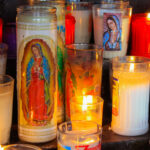Guadalupe Day or Day of the Virgin of Guadalupe, on December 12, draws millions of Catholics every year from across Mexico and other countries to pay pilgrimage to see an image of Mary in the Basilica of Guadalupe. It is the site of her apparitions to Juan Diego Cuauhtlatoatz in 1531, now the most visited Catholic site in the world. Children are dressed in traditional costumes and are blessed in churches. Thousands of people come to church to pray. Guadalupe’s famous image, a brown-skinned woman in a starry blue mantle, hands folded in prayer, is cherished in Mexico. She is a remarkable part of believers’ daily lives — in their homes, churches, prayers, and community life. The day has been declared a national holiday in Mexico.
Even though it is a national holiday, most companies and organizations organize masses and feasts for their employees. On this day, people from all parts of Mexico make their way to Mexico’s religious center at the Basilica of the Virgin of Guadalupe, located in Villa de Guadalupe Hidalgo. This is a northern neighborhood of Mexico City where they celebrate the Nuestra Senora de Guadalupe with a mass ceremony and a fair in her honor.
History of Guadalupe Day
Day of the Virgin of Guadalupe Day is a story of miracles and faith that marks an important shift in the history of Mexico. The Spaniards, after they conquered Mexico, wanted to convert the indigenous Indians to Catholicism. But the Spaniards encountered many difficulties because the Mexican had their own faith and spirituality in which they strongly believed. However, indigenous people started to become fascinated with Catholicism when the story of the Virgin of Guadalupe and Juan Diego came to the fore.
According to tradition, Mary, mother of Jesus, appeared to Juan Diego, who was an Aztec convert to Christianity, on December 9 and again on December 12, 1531. Juan Diego was a young indigenous Indian who was walking toward the Hill of Tepeyac when he was stopped by an appearance of the Virgin Mary. According to Diego, the Virgin Mary was a young woman with black hair and dark skin who looked more like the women in his community. She ordered Diego to go to the Bishop and ask him to build a church at the Hill of Tepeyac. Diego then ran to the Bishop to tell him what the Virgin Mary had told him. The Bishop did not believe Diego at first and disregarded his request to build a church at the Hill of Tepeyac, demanding a sign before he would approve the construction of a church.
Mary then appeared a second time to Juan Diego and ordered him to collect roses. In a second audience with the bishop, Juan Diego opened his cloak, letting dozens of roses fall to the floor and revealing the image of Mary imprinted on the inside of the cloak — the image that is now venerated in the Basilica of Guadalupe.
Although the traditional view has been questioned by various scholars, defenders of the Virgin of Guadalupe — including Pope John Paul II, who canonized Juan Diego and declared Our Lady of Guadalupe the patroness of the Americas — accept the authenticity of the early documents and the various oral accounts of the apparition. Since 1556, a shrine devoted to the Virgin has existed in Tepeyac Hill.
Veneration of Our Lady of Guadalupe has been particularly strong among women, especially in Mexico, and since at least the early 18th century the devotion was spread throughout the world by the Jesuits and other religions. However, it’s not only limited to religious matters.
Our Lady of Guadalupe’s role has also played an important role in Mexican nationalism and identity. For example, in 1810, Miguel Hidalgo y Costilla promoted her as the patroness of the revolt he led against the Spanish.
During a religious revival in Mexico in the late 19th century, preachers declared that the foundation of Mexico could be dated to the time of the apparition of Our Lady of Guadalupe because she freed the people from idolatry and reconciled the Spanish and indigenous peoples in a common devotion. Her continuing significance as a religious and national symbol is attested by the hundreds of thousands of pilgrims who visit her shrine every year.
Guadalupe Day timeline
Jesus is born in Bethlehem.
Crusaders invade and conquer Jerusalem.
According to tradition, Mary appears to Juan Diego twice, requesting a shrine to be built on the spot where she appeared and sending a sign of roses with her image imprinted inside of Juan Diego’s cloak.
After the story of Mary’s appearance to Juan Diego was codified in the work of Miquel Sánchez, an account in the indigenous language — Nahuatl — is published and widely accepted as accurate.
The Dogma of Papal infallibility is proclaimed.
During the civil war in Mexico, the banners of the rebels bore Our Lady of Guadalupe’s image with zeal and fervor.
Our Lady of Guadalupe is named ‘The Queen of Mexico and Empress of the Americas’ by Pope Pious XXII.
Guadalupe Day FAQs
What does Our Lady of Guadalupe symbolize?
It marks the date in 1531 when the Virgin Mary purportedly appeared to an indigenous Mexican, in the last of several apparitions. To the present day, Our Lady of Guadalupe remains a powerful symbol of Mexican identity and faith, and her image is associated with everything from motherhood to feminism to social justice.
Who is the angel under Our Lady of Guadalupe?
The woman is standing on the moon, indicating that she is greater than the god of night, the moon god. The “angel” at the bottom of the image was seen by the Indians as an “intermediary god” carrying in a new era, the beginning of a new civilization.
Is the Virgin Mary and Virgen de Guadalupe the same?
The Virgin of Guadalupe refers to when the Virgin Mary — the mother of Jesus and a very important saint in the Roman Catholic religious tradition — appeared to a man named Juan Diego in Mexico in 1531. She holds a special place in the culture and religious life of many Mexicans and Mexican Americans.
How To Observe Guadalupe Day
Attend a vigil
Our Lady of Guadalupe is an important part of Mexican identity and is celebrated by Mexicans all over the world. If you’re Catholic or have Mexican family members or friends, consider attending a vigil. The night before the Feast Day, the Mexican community gather in a circle outside a church, reciting prayers and recounting the story of the appearance of Mary to Juan Diego. After completing prayer, they move into the church and sing songs in celebration of Our Lady of Guadalupe. If you can find a festival or parade nearby, make sure to attend it. Music, costumes, dances, and feasts are the best way to celebrate.
Learn about Juan Diego
Although there is no hard evidence St. Juan Diego ever existed, he was canonized nonetheless and is a revered symbol in Mexican belief and culture. Since the lively Mexico City neighborhood of Tepeyac stands the most-visited religious site in the West, The Basilica de Guadalupe, a great way to increase your knowledge about Catholics in Mexico is to learn about Juan Diego and how his visions of Mary influenced nationalistic pride and symbolism. Either read up online or even ask a Mexican friend or family member who is Catholic what Juan Diego’s visions mean to them.
See the Basilica de Guadalupe
If you’re ever in Mexico or live in Mexico, consider actually visiting the Basilica de Guadalupe. The image of Guadalupe is one of the most important patriotic symbols in Mexico, with devotion combining elements from Spanish and Aztec religion, reflecting the mixture of the cultures which together form the country.
5 Amazing Facts About Guadalupe Day
Surviving blasts
Over the years, Our Lady of Guadalupe has gained a reputation as a powerful miracle worker — for example, an anti-Catholic radical concealed a bomb in a bouquet in 1921, where the blast smashed windows and destroyed the marble altar, but the image itself was left unharmed.
The unscathed image
Some researchers have claimed that the image of Mary left on the cloak of Juan Diego has miraculously survived the humid air of Mexico City, when it should have deteriorated years ago.
Skin color progression
Art historians have discovered that depictions of the Virgin's skin color have become progressively darker, possibly due to the Mexican revolution which led to the exaltation of the mixed-race mestizo as the new model of ‘Mexicaness.’
Mary as a national patroness
Mexico’s independence from Spain in 1810 transformed Our Lady of Guadalupe into the national patroness, with the Mexican Virgin emblazoned on flags, banners, and peasant sombreros as an armed rebellion against Spanish rule.
A previous Aztec site
Prior to Juan Diego’s alleged appearance in 1531, an Aztec goddess called Tonantzin was worshipped — this means "Our Mother" in the Aztec language of Nahuatl, so some skeptics contend that the Spanish colonial church concocted the story of Guadalupe appearing to Juan Diego as a way to convert his fellow Aztecs and other indigenous groups to Christianity.
Why Guadalupe Day Is Important
It’s an important part of culture
Whether you believe in Juan Diego’s visions of Our Lady of Guadalupe or not, there is no doubt that the figure of Mary holds a special place in Mexican faith and culture. Her image graced banners in the 1810 revolt against the Spanish and was carried 100 years later as a symbol of patriotism by leader Emiliano Zapata and his troops as they marched into Mexico City during the Mexican Revolution.
It’s sacred to millions of people
A whopping 20 million people from all over Mexico and the world flock to the Basilica de Guadalupe to pay pilgrimage every year. The basilica is the most visited Catholic pilgrimage site in the world and the world's third most-visited sacred site.
It’s a nationalistic symbol
Some Mexicans might tell you that 90 percent of them are Catholic but 100 percent are Guadalupan. While the proportion of Catholics in Mexico isn't accurate anymore, the Virgin of Guadalupe remains a cherished part of Mexican national identity, reflected in the fact that millions of women and men are named Guadalupe, many going by the nickname ‘Lupe.’
Guadalupe Day dates
| Year | Date | Day |
|---|---|---|
| 2025 | December 12 | Friday |
| 2026 | December 12 | Saturday |
| 2027 | December 12 | Sunday |
| 2028 | December 12 | Tuesday |
| 2029 | December 12 | Wednesday |


















